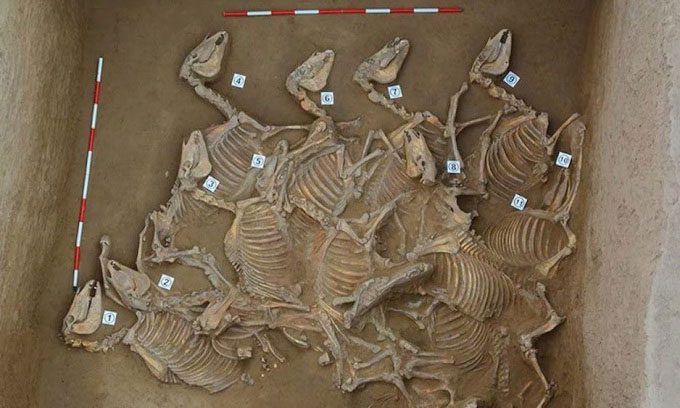Experts have discovered the remnants of a city that may have once been a political and cultural center in China, featuring large pits filled with horse bones.
The newly uncovered city, called Yaoheyuan, was surrounded by city walls and dates back to the Bronze Age, according to a report by Live Science on October 31. It served as a political and cultural hub during the Western Zhou Dynasty, a period in Chinese history that lasted from 1045 to 771 BCE.

One of the six horse sacrifice pits excavated at Yaoheyuan, northwest China. (Photo: Kai Bai/Antiquity Publications Ltd).
Yaoheyuan is located at the foothills of the Liupan Mountains in northwest China. While there are other Bronze Age sites scattered throughout the region, archaeologists believe Yaoheyuan may have been a central hub due to the scale and variety of the architectural remains discovered.
Human and animal sacrifice was a common practice at Yaoheyuan, as the team of experts found numerous tombs containing disarticulated human bones, along with horses, cattle, goats, sheep, chickens, dogs, and rabbits buried alongside. Notably, they uncovered six sacrifice pits filled with layered horse bones, with some skeletons shattered into multiple pieces, suggesting they were likely dismembered before being discarded. In total, 120 horses were found, including several foals.
“The consumption of horses and the sacrifice burial pits not only reflect the wealth and status of Yaoheyuan but also indicate the abundance of horses in this area. Horses were one of the most important resources in northwest China during the Western Zhou period.” the research team stated. Additionally, scientists excavated a variety of artifacts, including ceramic molds, jade and stone objects, lacquerware, celadon vases, and bones inscribed with over 150 hieroglyphs.
To date, there has been limited research focusing on the Western Zhou period. Experts need to conduct further studies to better understand the significance of Yaoheyuan during this era and its relationship with other regions in China. “These new findings provide important evidence for examining the political and cultural context of northwest China, as well as reassessing the connections between central hubs and their surrounding areas at the end of the Bronze Age.” the research team concluded.





















































